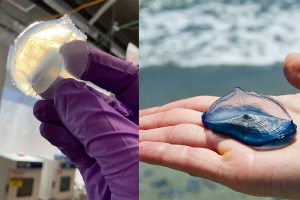
Using a design inspired by one of the ocean’s best sailors, scientists at the Johns Hopkins Applied Physics Laboratory is developing a low-cost sensor for ocean observations. The APL team includes EP Instructor Leslie Hamilton, who teaches Biomimetics in Biomedical Engineering – 585.726.
The sensors are modeled after velella, which are floating jellyfish-like organisms that sail across the surface of the ocean.
The new sensor platforms—developed with support from the Office of Naval Research and in collaboration with the Naval Postgraduate School and a local aerospace electrical engineering company—incorporate advanced low-power electronics that can measure key oceanic factors, such as salinity, temperature, and position. The data is then transmitted to researchers using satellite communication for real-time global monitoring.
Measuring Salinity

EP Instructor and APL scientist Leslie Hamilton
Salt makes water denser, and while surface water circulation is driven primarily by surface winds, changes in seawater density and temperature drive ocean currents deep below the surface. Global ocean circulation models suggest that these density-driven deep currents play a significant role in mediating our planet’s climate, as well as ocean nutrient and carbon dioxide cycles.
Though satellites are capable of capturing salinity data from large portions of the ocean, data from buoys and in-water devices, such as the Velella velella sensors, provides localized, high-resolution readings.
“If we can better monitor ocean health and how environments around the world are changing, then we can make better decisions on how to mitigate or adapt to those changes,” says Hamilton.
Modeled After Nature
Nicknamed “by-the-wind sailors,” the Velella velella that inspired APL’s sensors form large schools and feed on plankton as they float across the sea, propelled by winds pushing on their sails. For the biomimetic sensors to pack such a technologically heavy punch in such a small package, many components are multifunctional.
“Not only does the sail capture wind, it’s also a feature to house electrical components, like antennae, that need to sit above the waterline,” says Kyle Lowery, a mechanical design engineer at APL. “And the bottom of our Velella velella resembles a ship’s keel, which simultaneously houses the bulk of the electronics, provides a convenient location for the salinity sensor, and lowers the sensor’s center of gravity for stability.”
In areas of the ocean that are nutrient and plankton scarce, real Velella velella can capture the power of the sun using symbiotic algal cells and then turn that power into energy via a process similar to photosynthesis. Each of APL’s Velella-inspired silicone sensors harvests the energy of the sun, too, using two solar arrays above its fin to power its tiny electronics.
“As it floats in the ocean, the solar energy will recharge the battery,” says APL electrical engineer Daniel Ayoub. The salinity sensor will be submerged and continuously measuring salinity levels.
Adaptable Aquatic Communicators
The electronics, which can be adapted for a variety of research interests, are designed to periodically report temperature, position, and salinity via satellite communication. To test these capabilities, an early electronics prototype was deployed via weather balloon from the Delaware coast. The prototype is currently in the middle of the Atlantic and has been reporting position and temperature multiple times a day for over 20 weeks.
To perform initial buoyancy tests, the team set the sensors afloat in the APL pond. This was followed by a tethered release in the Pacific Ocean. Recently, researchers at the Naval Postgraduate School deployed the latest iteration of their design in Monterey, California. The sensor is currently tethered to a pier to allow for continued testing and evaluation in a real ocean environment.
In future testing phases, researchers will deploy a collection of devices that resemble Velella velella‘s natural school structure and are capable of providing larger sets of critical oceanic data.
(This story is adapted from JHU Magazine, with additional images courtesy of Johns Hopkins Applied Physics Laboratory.